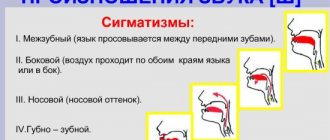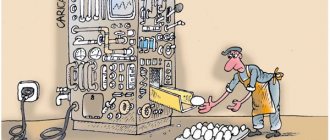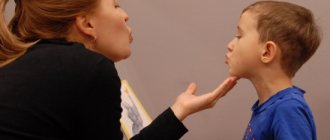A lisp is a speech defect in which there is incorrect pronunciation of hissing and whistling sounds. At the same time, the defect does not in any way affect the understandability of speech and the correctness of its grammatical and logical structure. A speech therapist can help a person figure out how to stop lisp, as well as some tips for working on restoring speech at home.
What is a lisp?
A lisp is a speech defect associated with incorrect pronunciation of the sounds “s”, “z”, “ts”, “sh”, “zh”, “ch”, “sch”.
“It’s not the curdled milk of the matrefka, but the shmetan,” that’s what it means to have a lisp.
In this case, neither the grammar nor the logic of what was said is violated. But it may not always be clear what people with a lisp are saying.
In childhood up to 5 years of age, the speech apparatus develops, so when a child has a lisp at 4 years old and recites:
“Shasha walked along Shosha and shoshka shushka” - this evokes emotion.
It's another matter if an adult has a lisp. Here, during communication, completely different feelings arise: tightness and embarrassment on the one hand and awkwardness on the other. Therefore, it’s probably not worth trying to correct it, and especially not considering a lisp as an individual feature. Although this is a purely personal matter.
Symptoms
The main symptoms of a lisp include the following:
- incorrect positioning of the tongue when pronouncing sounds;
- difficult and incorrect pronunciation of whistling and hissing sounds;
- patients try to avoid pronouncing difficult words;
- children can confuse syllables, replacing complex syllables with easier ones to pronounce;
- Many people with a lisp withdraw into themselves and try to minimize live communication, preferring text communication.
Identifying the disorder among children whose speech is just beginning to develop can be difficult. Adult patients, in turn, are strongly recommended not to be embarrassed by a lisp, but to immediately consult a specialist.
Causes of lisp
Why do people lisp? What are the causes of a lisp?
It can be:
- Disturbances in the functioning of the speech apparatus, for example, atony of the tongue or an undeveloped frenulum. As a result, articulation fails and sounds are distorted.
- Malocclusion and dental problems. The absence of front teeth makes speech whistling, and it is not possible to clearly pronounce the sounds “ch”, “sch”, “zh”, “sh”.
- Severe stress and prolonged nervous tension. In this case, muscle tone is disturbed, and this negatively affects the clarity of spoken words.
A sharp fright can cause a child to begin to lisp at the age of 4, although before that he spoke correctly.
Why does a person lisp? The reasons are clear. Then a logical question arises: what to do about it:
- how to remove a lisp;
- how to stop a teenager from lisp;
- How to get rid of a lisp in an adult?
Causes
Speech disorders do not arise out of nowhere. As a rule, changes in the functioning of the speech apparatus are preceded by certain events. Experts identify several factors that answer the question “Why does a person have a lisp?”:
- pathologies of the organs of the speech apparatus observed in a child from birth. An improperly developed frenulum, deviation in the length of the tongue, thick lips, etc. may be responsible for the development of pronunciation disorders of hissing and whistling sounds;
- developmental disorders of the maxillofacial apparatus, including malocclusion, high palate, diastema and other pathologies;
- neurological disorders that have a negative impact on the articulatory apparatus;
- if one of the family members suffers from this problem, the child lisps, imitating his manner of speech;
- physical damage to the facial part of the head;
- this disorder is often diagnosed in older people, due to hearing loss or missing teeth;
- hereditary predisposition.
This speech disorder is not a death sentence, which means there are ways to get rid of a lisp. The first step towards speech restoration is identifying the defect by its symptoms.
Correction methods
The problem is solvable. But we have to try!
If it is quite simple for a child to correct a lisp due to the fact that the articulatory apparatus is soft and pliable, then with age some muscles are in excessive tone, while others, on the contrary, atrophy. And solving the problem: how to remove a lisp in an adult becomes more difficult.
And yet, how not to lisp? Here are some tips on how to get rid of a lisp in your child.
Exercises to develop the articulatory apparatus
In children, speech impairment may go away spontaneously by the age of 7, but it won’t hurt to show the child to a specialist in time.
Due to a lisp, which becomes a source of stress, a person’s quality of life decreases. Older children, and especially teenagers, become withdrawn and avoid communication because they cannot clearly express their thoughts.
Diagnostics
At the first manifestation of symptoms of a lisp, you should contact a speech therapist, who will assess the degree of development of the pathology and show you how to learn to perform the exercises that form the basis of the correction course. During the inspection, the specialist records the following points:
- the way the patient pronounces sounds;
- features of the functioning of auditory and visual channels of information perception;
- work of the articulatory apparatus;
- psychospeech development of the patient;
- writing and reading skills;
- memory quality;
- literacy in speech construction.
Depending on the reasons that provoked the occurrence of deviations, the patient may be referred to an appointment with a dentist, surgeon or otolaryngologist.
How can teenagers and adults stop lisping?
With age, when determining the causes of a lisp, the need often arises for surgical correction of the muscles or frenulum of the tongue, correction of the bite or dental prosthetics.
Visiting a speech therapist and working under his guidance will make speech production effective. But if, despite the fact that the process of correcting speech is complex and lengthy, you are full of perseverance and perseverance, you can do the correction yourself.
The cork exercise is one of the most effective. With a cork clamped in your teeth, you can tell stories or read poetry. Reading with your mouth closed also gives good results. You can devote half an hour a day to this activity, trying to pronounce sounds loudly and clearly.
Tongue twisters are our everything!
Tongue twisters for people with a lisp are a kind of gymnastics for the speech apparatus, which, with due patience and systematic practice, gives good results, allowing you to restore speaking skills.
Tongue twisters are classics of correctional work with speech defects.
Here are examples of tongue twisters for lisps: they are intended for “the development of various problematic letters: Zh, Sh, Z, S and Ts, Ch, Shch.
Correction
Restoring the correct functioning of the speech apparatus requires quite a long time and does not give immediate results, although in the case of surgical intervention some improvements are possible within a week after the operation.
The correction is based on an integrated approach to how to stop a lisp, and includes not only speech therapy measures, but also the work of a teacher, psychologist, dentist and other specialists as necessary in each individual case.
In the problem of how to learn to live without a lisp, correction of sound pronunciation and proper breathing, exercises to develop the articulatory apparatus, tongue massage and other procedures will help. In especially severe cases, an adult patient may require dental prosthetics, bite correction, or surgery to correct the muscles of the tongue.
Correction is much easier if the child has a lisp before the age of 7. Correction of sound pronunciation at this age is carried out naturally, subject to certain rules and exercises to prevent the development of pathology. It is more difficult for a teenager, like older patients, to deal with a lisp, but you can get rid of it by strictly adhering to the plan drawn up by a specialist.
Exercises to correct the pronunciation of sounds
Several basic exercises created by speech therapists will tell you how to learn how to correct sound pronunciation yourself. If you do these exercises regularly, the results will not be long in coming.
- Relaxation. Licking the upper lip from top to bottom will help relax the muscles of the tongue. After completing this exercise, you can move on to pronouncing sounds with which you have difficulty.
- Cup. To complete this task, you need to fix your jaw in one position. Make a kind of cup with your tongue, equally lifting its side and front walls. Next, you need to try to pronounce the sound [z], which in this exercise will be more similar to [z].
- Cork. Reading aloud with a bottle cap clamped in your teeth has a good effect on the development of the speech apparatus. There are usually no difficulties in learning to read with a foreign object in your teeth.
- Reading through lips. Doctors recommend regularly reading small pieces of text with your mouth closed. It is necessary to compress your lips tightly, slightly opening your teeth, and begin to read the text so that it can be heard.
- Tongue Twisters. One of the best ways to correct a lisp is to memorize and pronounce tongue twisters. In order not to develop a problem in the form of a lisp, it is necessary to pronounce tongue twisters as a preventive measure.
The above describes only the basic exercises for correcting a lisp. In fact, there are many more of them. In addition to completing tasks to develop the speech apparatus, it is also necessary to devote time to breathing, which often becomes confused during excitement and causes incorrect pronunciation of sounds, thereby creating problems not only for people with a lisp.
Parents of a small child should take note of how to learn to speak correctly with him as he develops. As a preventative measure, it is necessary to do various play exercises with the baby to establish the correct sound pronunciation, and also teach the child tongue twisters.
People have a lisp for a variety of reasons. Some people even like this feature, but experts remind that a lisp is a problem that needs to be addressed, even though it does not cause any significant harm to health.









